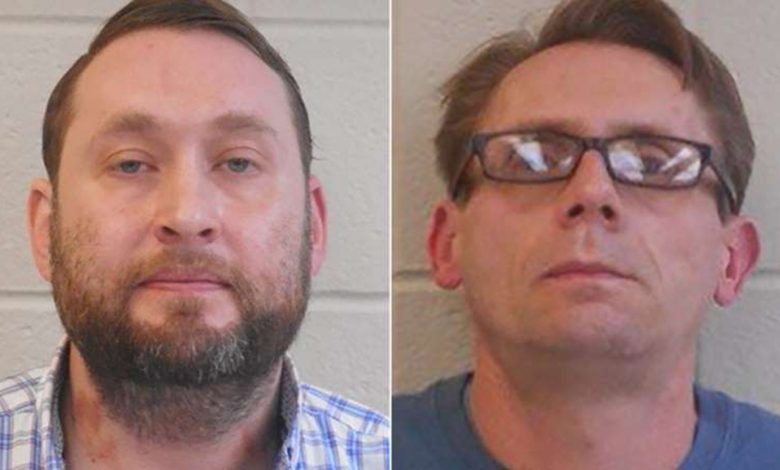By P.J. Tracy
Murfreesboro Diamond
Two Henderson State University associate professors, including a former Delight graduate, have been charged with manufacturing methamphetamine and use of drug paraphernalia.
The professors, Terry David Bateman, 45, and Bradley Allen Rowland, 40, were arrested last Friday in Clark County.
Bateman, a Delight High School 1992 graduate, is listed on the HSU website as an associate professor of chemistry and director of research chemistry and had been employed by the University for a decade. Rowland’s listed title associate professor of chemistry.

KARK.com, a news affiliate in Little Rock, states that in 2014 then HSU student Jacob Lankford conducted an interview with the recently hired Rowland. In the interview Rowland evidently spoke glowingly about the television show “Breaking Bad” in which a high school chemistry teacher uses his scientific knowledge to operate a meth lab.
According to the arrest affidavit from the Clark County Sheriff’s Department singed by Sheriff Jason Watson, the investigation began in December 2018 when Elaine Kneebone, HSU legal counsel, notified authorities that Bateman and Rowland “had recently exhibited marked deviation in their behavior” that led some fellow faculty members to believe they “were involved in some type of illegal activity in one of the chemistry laboratories.” The pair, which exhibited “drastic changes” in their appearance and weight loss, were seen in the laboratory during late night and early morning hours. The pair also became possessive of the REY304 laboratory located in the Reynold Science Center on the HSU campus, allegedly questioning those who entered the lab about their intentions and not letting those people out of sight.
On Jan. 4, 2019, Roy Bethel of the Group 6 Narcotics Unit and Clark County Deputy Sheriff Wes Sossamon were given access to the laboratory by the University.
Using what the affidavit calls their “extensive experience in the investigation of clandestine drug laboratories” they began a search for ingredients specifically used in the manufacture of illegal substances. Two ongoing chemical reactions were present at the time, including an odor similar to phenyl-2-propanone, a controlled substance used in the manufacture of methamphetamine, but the pair found no other tell-tale signs of illegal drug activity.
On Oct. 8 of this year, Henderson State University was forced to close the Reynolds Science Center after a chemical spill in the REY304 laboratory produced noxious fumes and forced the school to go into chemical hazard protocol after “chemical saturation of the ambient air” was determined. The center did not reopen until October 29.
The day previous, three students were present in the science center at approximately 9:30 p.m., and were overcome by a strong chemical odor. The students also placed Rowland and Bateman at the scene at the time, with their pair told one of the students that the spilled chemical “might have been benzyl chloride.”
Benzyl chloride is commonly used in the manufacture of phenyl-acetic acid, a precursor step to the chemical synthesis of phenyl-2-propanone.
The State Crime Laboratory was called in to investigate, and after a preliminary investigation, the laboratory was secured under the direction of the HSU campus police.
According to the HSU Oracle, around that time, Bateman, Rowland and Wray Jones, an assistant chemistry professor and chemical hygiene officer were all placed on administrative leave according to students whose classes were being taught by different professors. Bateman’s replacement, Edyta Schranz, reportedly told the students at the time that Bateman may or may not return.
A month later, on Nov. 8, the Clark County Sheriff’s Department apprised that samples taken from the lab did test positive for either methamphetamine or phenyl-2-propanone that had been manufactured inside the university laboratory.
The state crime lab further stated that in their expert opinion, “this particular manufacturing process would have had to have been conducted by someone with a level of knowledge consistent with a professor … a chemistry student would not possess the requisite knowledge or skill.”
On Nov. 11, warrants were issued for the search of Bateman and Rowland’s offices in the Reynolds Science Center, and handwritten documents containing chemical formulas were seized from Rowland’s office, as well as documents of an incriminating nature from Bateman’s office. Also, after opening a safe in Bateman’s office, authorities discovered 190 glass vials containing “visible residue.”
On the tip of another professor, two glass flasks were seized from a laboratory refrigerator. The professor told authorities that Bateman and Rowland were paying close and consistent attention the flasks in question.
Two days later, three more flasks were sized from a laboratory freezer, which field tests showed to contain methamphetamine that exceeded two grams.
Watson reportedly credited the Arkadelphia police, the regional narcotics task force and Henderson State University contributed to the investigation.
According to the Arkansas Annotated Code, manufacturing methamphetamine with an amount of two or more grams is a Class Y felony, which can carry a sentence of up to 40 years in prison, with a minimum of a 10 year sentence.








